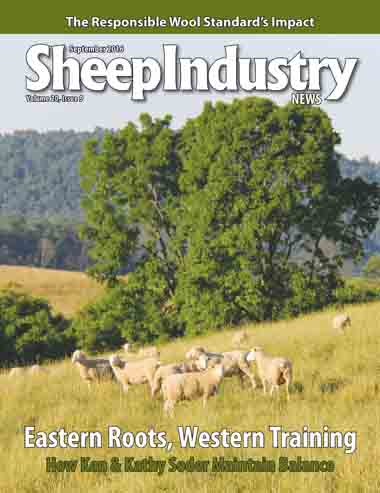
- September 2016
- President’s Notes
- Should Your Wool Be RWS Certified?
- Patagonia Buys American in Wool Restart
- Reporting Rules Show Little Change
- Eastern Roots, Western Training
- Genetic Data Pays Off at Sale Barn
- UK Ovine Genetics Available Again in U.S.
- Polypay Takes on Parasite Study
- Comments Submitted on Uruguay Proposal
- Obituaries
- Market Report
- The Last Word
To View the September 2016 Digital Issue — Click Here

Regulation Overdrive
Burton Pfliger, ASI President
ASI works on federal regulations often times as much as legislation. In 2015 and 2016, the regulatory side of representing sheep producers and feeders has been very prominent.
Much of last year was consumed with the new Department of Labor regulations governing our H-2A sheepherder program, as well as reaction to the Waters of the U.S. proposal.
We started this year with active support of a proposed rule by the U.S. Department of Agriculture to increase lamb market transparency and accuracy. Following the annual meeting in January, we met with USDA’s Agricultural Marketing Service on a draft proposal it was interested in presenting to the sheep industry, wondering whether or not it should be pushed to the point of receiving public comment.
Peter Orwick and I covered the meeting for ASI with other livestock and meat-industry groups. The department took input from ASI and lamb meat companies and issued the proposed reporting updates for public comment in March. However, in August, the decision came back to implement only one of the three proposals. It is a disappointing decision considering the four years of effort by the ASI Lamb Council – with a significant investment of funds and time to pursue – as well as a lot of time spent by USDA.
We gained a better lamb report overall with changes we supported in the congressional reauthorization of mandatory price reporting in the fall of 2015 adding, I believe, one new packer to reporting and four importing firms. We anticipate a study from leading economists prior to the next reauthorization that will show deficits and improvements that we can hopefully work from on your behalf.
At Sheepusa.org you can view the comments from ASI and others on another ag proposal that would allow bone-in lamb from Uruguay into the United States. We worked with risk analysis experts and provided USDA with a number of issues that should be addressed in order to protect American agriculture and economy from Foot and Mouth Disease. We asked that they pull the proposal until the out of date reviews and questions are resolved. My own thought is there is a reason lamb imports from that country have been boneless only, as is the case today with beef imports from Uruguay.
At press time, we were drafting (with animal health and veterinarian volunteers) a formal response to yet another proposed regulation by USDA to update our BSE restrictions in international trade. This rule has been years in the making and again we are reviewing to protect the American sheep industry. Obviously, we don’t want any regulations that would weaken our scrapie eradication program in America. We have invested tens of millions in funds by government and sheep operations to advance the most aggressive eradication program on the face of the earth. We certainly don’t want that undone, so we have to ensure our government does it correctly.
Ultimately, there will be some changes in trade as USDA matches BSE regulations to international standards – perhaps in breeding stock or germplasm. We have read a lot lately – as you likely have – from the United Kingdom about sheep farmers expecting to trade meat here. If allowed for the first time since 1993, they will surely find the U.S. market is one of the most crowded in the world. Their English cousins from Australia and New Zealand are already more than filling the import role.
The sage grouse decision on ESA listing was a positive for our industry. Ranchers have been very proactive in the Dakotas, Montana, Utah and Wyoming, but new federal land management plans coming to light might be even more restrictive than an endangered species listing. In some cases, proven state plans aren’t being given the respect they deserve, given their positive results.
At the rate we are seeing regulations, I might have to write on this topic again in a month or two.
In other news, sales of the Sheep Production Handbook have been brisk this summer with the new edition available in time for the fall semester at universities all across the country. Let’s Grow program events also continue each month. We had a national webinar in recent weeks that you can view on our website, as well as two sponsored events in Idaho in the past month with more on the horizon in other states.
I am pleased the executive board recommended budgets for the coming year that the ASI board will have voted on by the time you read this column. We can then reload the program accounts and move forward in wool, education, animal health and on the legislative and regulatory programs of ASI.
Also, the new cost of sheep production budgets are available for your use. The budgets – built by agriculture economists well acquainted with the sheep industry – are split into several regions so you can choose the one that is most similar to your location and production style. I think it is helpful to look at all the production expense and revenue averages to then view what can be done on your operation.

